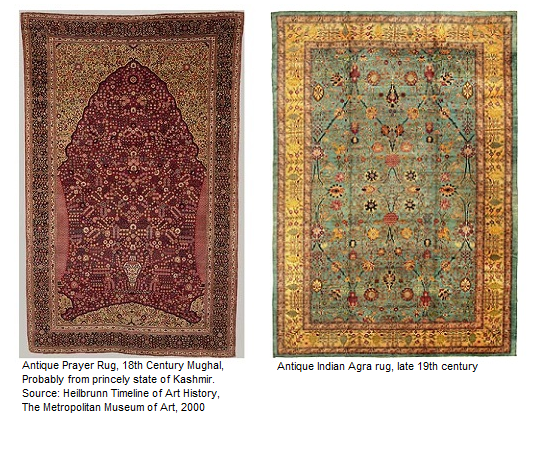Carpet weaving was brought to India by the great Mughal Emperor Akbar in the 16th century and is known as Mughal carpets (or Moghul/Mogul carpets). It is said that when Babur came to India, he was disappointed by lack of luxuries here. He missed the luxuries of Persia, which included the Persian carpet. Akbar laid the foundation of carpet weaving tradition in India, in 1520 AD, when he brought some carpet weavers from Persia, at his palace in Agra. With their support he established carpet weavings centers at Agra, Delhi and Lahore to facilitate production of Persian styled carpets, which were inspired by designs of: Kirman, Kashan, Isfahan and Herat.

King Akbar, who was a illiterate himself was a great propagator of the arts and culture and it was during his reign that the arts flourished in India. Because of a lot of ruckus in the jails he decided to reform the system. Between 1520-30's he instructed the carpet weavers from Persia he brought with him, some of the finest carpet weavers from the most well known carpet workshops of Persia, to teach the prisoners the art of weaving carpets. These jail birds took a lot of pride in their work and they eventually outshone their masters.

The carpets were made for the palaces in India and some were also sent abroad in the form of gifts. Since there was no shortage of money , labour or of time constraint, it could take hundred weavers up to 15 years to make a single carpet. They used the finest wools, velvets, silks and sometimes even "Pashmina" (Cashmere) which is considered to be one of the most exotic fibres for weaving shawls. The dyes were all natural dyes/vegetable dyes extracted out of plants, rocks, minerals and insects. The designs were rare and quite different from the traditional Persian, Turkish and Central Asian carpet designs and a lot of these designs were original Indian patterns prior to the Mughal influence. The most famous jails for carpets were Agra Jail, Lahore Jail, Amritsar Jail, Jaipur Jail, Gwalior Jail and Bikaner Jail.
Mughals not only used the Persian technique of carpet weaving, but were also influenced by traditional designs and motifs from Persia. Mughal carpets were as intricate as their miniatures and often depicted court life, animals and floral decorations. Mughal carpets were brightly coloured and the hand knotted silk carpets had 4224 knots per square inch. Some of the most exclusive carpets were created during the Mughal reign for the Mughal emperors and their courts, each carpet unlike the other but infused with a common magic of colours and design.

Shah Jahan, the 17thcentury Indian ruler who built the Taj Mahal, has always been considered an important patron of architecture. What is less known is that he was also a great patron of Indian carpets. Aside from patterns in the Persian manner, a series of distinctively Indian designs were developed, including scenic and landscape carpets; animal carpets with spirited chases backward and forward across the field; elaborate architectural latticeworks in the Italian manner, with floral content; and several magnificent prayer rugs with a prominent central flowering plant.

Sources and inspiration: Bérinstain, Valérie, et al. L'art du tapis dans le monde (The art of carpets in the world),. Paris: Mengès, 1996. Print.; Jerrehian Jr., Aram K.A. Oriental Rug Primer. Philadelphia: Running Press, 1980. Print.; Herbert, Janice Summers. Oriental Rugs, New York: Macmillan, 1982. Print.; Hackmack, Adolf. Chinese Carpets and Rugs, Rutland and Tokyo: Tuttle, 1980. Print. ; De Moubray, Amicia, and David Black. Carpets for the home, London: Laurence King Publishing, 1999. Print.; Jacobsen, Charles. Oriental Rugs A Complete Guide, Rutland and Tokyo: Tuttle, 1962. Print.; Bashir, S. (n.d.). Personal interview.; Web site sources and dates of consultation vary (to be confirmed). Without prejudice to official usage.


 Tapis d'Orient Bashir | Bashir Persian Rugs
Tapis d'Orient Bashir | Bashir Persian Rugs
 @tapisbashir
@tapisbashir
 @bashircarpets
@bashircarpets
 @bashircarpets
@bashircarpets